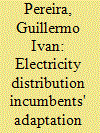|
|
|
Sort Order |
|
|
|
Items / Page
|
|
|
|
|
|
|
| Srl | Item |
| 1 |
ID:
183044


|
|
|
|
|
| Summary/Abstract |
Electricity distribution prices have steeply increased in Finland since 2015. This research investigates the returns from the Finnish low-voltage electricity distribution business and compares them to returns from three European industry indices. The within-industry distribution of returns is also studied. The Finnish rate of return regulation model used is presented together with the level of allowed returns by the model, four changes to the model are proposed, and the effect of the four proposed changes on the returns allowed by the model are investigated.
|
|
|
|
|
|
|
|
|
|
|
|
|
|
|
|
| 2 |
ID:
150832


|
|
|
|
|
| Summary/Abstract |
Economic network regulation increasingly use quantitative performance models (from econometrics and engineering) to set revenues. In theory, high-powered incentive regulation, such as revenue-caps, induces firms to cost-efficient behavior independent of underlying model. However, anecdotal evidence shows regulated firms occasionally maintaining cost-inefficiency under incentive regulation even under slumping profitability. We present a model for firm-level efficiency under a regime with a probability of failure explaining this phenomenon. The model is based on the hypothesis that the regulatory choice of method can be associated with intrinsic flaws leading to judicial repeal and replacement of it by a low-powered regime. The results show that the cost efficiency policy is proportional to the type of firm (cost of effort), value of time (discount factor) and the credibility of the method (risk of failure). A panel data set for 2000–2006 for 128 electricity distributors in Sweden is used to validate the model predictions (radical productivity slowdown, failing profitability and efficiency) at the launch and demise of a non-credible regulation method. The work highlights the fallacy of viewing incentive regulation as a method-independent instrument, a result applicable in any infrastructure regulation.
|
|
|
|
|
|
|
|
|
|
|
|
|
|
|
|
| 3 |
ID:
126539


|
|
|
|
|
| Publication |
2013.
|
| Summary/Abstract |
Various electricity reforms have been adopted by a number of countries within the last 2 decades. Turkey, as one of those countries, has restructured its electricity market and intensively privatized the distribution companies. As one of the main targets of the liberalization efforts in the sector was announced to be reduced consumer prices, it is a matter of interest to look at the related developments after privatizations. Hence, this study attempts to explore the impact of power distribution privatization in Turkey on the national end-user electricity prices. Results of the analysis suggest that privatization of electricity distribution companies has not yielded the expected retail price declines within the first 4 years of the program. Whereas wholesale tariffs exhibit a reduction in the rate of 10%, retail tariffs show an increase of 5.9% within the period in question. Besides, the unstable patterns of the two tariffs imply that the market is not yet ready for the automatic pricing mechanism planned to be implemented based on a cost-reflective methodology. Therefore, results indicate that the factors behind the unsatisfactory outcomes of the program should be explored in order for the privatization efforts in the Turkish electricity distribution market to serve the purpose.
|
|
|
|
|
|
|
|
|
|
|
|
|
|
|
|
| 4 |
ID:
176827


|
|
|
|
|
| Summary/Abstract |
The transition to a cleaner and smarter electricity system is being spurred by new policy approaches aiming at delivering a decentralized, digital, and decarbonized energy future. This calls for the adaptation of incumbent technologies, policies, and actors, as well as for the introduction of new system components. The changing role of electricity distribution systems, and of distribution system operators, has been a focal aspect of recent market design efforts, given the critical role of network infrastructure and the importance to adjust its operations, and regulatory framework. We build on a novel dataset from 124 DSOs and apply a methodology combining Factor analysis and a Tobit model to evaluate the role of market, regulatory, investment, and firm-level factors on technological, business model, and market design adaptation. Our results indicate that hybrid regulatory models contribute to DSOs adaptation. Investing in smart grids is found to have a positive effect on adaptation. Regarding firm-level characteristics, the results indicate that unbundling does not affect adaptation, however larger DSOs are found to be better able to adapt. These findings provide timely empirical evidence for advancing regulatory and policy approaches toward the adaptation of incumbents in a rapidly changing electricity sector.
|
|
|
|
|
|
|
|
|
|
|
|
|
|
|
|
| 5 |
ID:
117328


|
|
|
|
|
| Publication |
2013.
|
| Summary/Abstract |
The quality of electricity distribution is being more and more scrutinized by regulatory authorities, with explicit reward and penalty schemes based on quality targets having been introduced in many countries. It is then of prime importance to know the cost of improving the quality for a distribution system operator. In this paper, we focus on one dimension of quality, the continuity of supply, and we estimated the cost of preventing power outages. For that, we make use of the parametric distance function approach, assuming that outages enter in the firm production set as an input, an imperfect substitute for maintenance activities and capital investment. This allows us to identify the sources of technical inefficiency and the underlying trade-off faced by operators between quality and other inputs and costs. For this purpose, we use panel data on 92 electricity distribution units operated by ERDF (Electricité de France - Réseau Distribution) in the 2003-2005 financial years. Assuming a multi-output multi-input translog technology, we estimate that the cost of preventing one interruption is equal to 10.7€ for an average DSO. Furthermore, as one would expect, marginal quality improvements tend to be more expensive as quality itself improves.
|
|
|
|
|
|
|
|
|
|
|
|
|
|
|
|
| 6 |
ID:
171385


|
|
|
|
|
| Summary/Abstract |
Frontier-based yardsticks, as applied in European energy network regulation, are not immune to strategic behavior. Under yardstick regulation, the regulator gauges the operator against a cost target set by the other firms in the sector. Many regulators have implemented frontier-based yardsticks where the cost function is defined by the most efficient firms (peers). This paper demonstrates that when it is possible to predict peers in advance, firms can manipulate the frontier to their advantage. We single out horizontal mergers as a plausible means to achieve such strategic objectives and develop a measure to identify strategic mergers ex ante. Using data from the electricity distribution sector in Norway that is subject to stable frontier-based regulation allows us to identify firm behavior that is consistent with our predictions. The paper contributes to the modern yardstick literature as existing evidence of strategic behavior in related regulatory settings is either based on anonymized questionnaire responses from regulatory authorities or relies on simulations using unidentified firms that are not actually exposed to such benchmarking in practice. The paper concludes by discussing policy implications.
|
|
|
|
|
|
|
|
|
|
|
|
|
|
|
|
| 7 |
ID:
181769


|
|
|
|
|
| Summary/Abstract |
In this study, we analyze the long-term effects of the privatization of electricity distribution companies carried between 1995 and 2000 in Brazil using statistical analysis of regulatory indicators of privatized and the remaining state-owned enterprises (SOEs). The sample includes indicators concerning service quality, losses, operational costs, and profitability from 34 distribution companies between 2008 and 2019, representing 97% of the market in energy terms. According to the results, private ownership positively affects both quality and financial indicators considering regulatory goals. Therefore, the privatization program seems to have achieved its original goal. In addition, partially privatized SOEs have similar quality indicators to private companies but do not achieve operational costs and profitability similar to regulatory references. The financial reports of remaining SOEs indicate the controlling federal states did not receive a positive net sum of cash flow in the last nine years. Privatization of such companies should improve financial indicators while maintaining or improving the service quality, besides generating revenue to the controlling federal states.
|
|
|
|
|
|
|
|
|
|
|
|
|
|
|
|
| 8 |
ID:
088985


|
|
|
|
|
| Publication |
2009.
|
| Summary/Abstract |
Deregulation of Japanese electric power industry began in 1995. After the amendment of Electricity Utility Industry Law in 1995, competition was partially introduced in a generation sector and retail competition started from 2000. Eligibility to choose suppliers was gradually extended from larger to smaller customers. As of 2008, almost all customers except households can choose their electricity suppliers. Based upon both previous implementation result of competition policy and review on their achievement, Japanese government will begin new policy debate in 2013 to assess further retail competition which includes household customers. To prepare for policy suggestion on the future electric power industry, this study examines the cost structure of Japanese electricity distribution. For the purpose, we estimate a multi-product translog cost function of Japanese electricity distribution from 1983 to 2003. Using the estimated cost function, we calculate several economic measures such as productivity growth, technical change and economies of scale and scope. The empirical results of this study indicate the improvement in productivity growth after deregulation.
|
|
|
|
|
|
|
|
|
|
|
|
|
|
|
|
| 9 |
ID:
094956


|
|
|
|
|
| Publication |
2010.
|
| Summary/Abstract |
In order to overcome the perverse incentives of excessive maintenance reductions and insufficient network investments arising with incentive regulation of electricity distribution companies, regulators throughout Europe have started regulating service quality. In this paper, we explore the impact of incorporating customers' willingness-to-pay for service quality in benchmarking models on cost efficiency of distribution networks. Therefore, we examine the case of Norway, which features this approach to service quality regulation. We use the data envelopment analysis technique to analyse the effectiveness of such regulatory instruments. Moreover, we discuss the extent to which this indirect regulatory instrument motivates a socially desired service quality level. The results indicate that internalising external or social cost of service quality does not seem to have played an important role in improving cost efficiency in Norwegian distribution utilities.
|
|
|
|
|
|
|
|
|
|
|
|
|
|
|
|
| 10 |
ID:
137716


|
|
|
|
|
| Summary/Abstract |
This paper examines the growing role of grassroots initiatives in the governance of urban energy systems. In recent years, research has increasingly underlined the potential for sustainable innovation of community-led bottom-up actions but has at the same time underestimated their potential impact on the governance of energy systems. Based on a strategic action field framework (SAF), this paper analyses the conflicts over the remunicipalisation of Berlin׳s electricity grid and investigates the creation and strategic development of two grassroots initiatives as well as their interaction with the local government and the established grid operator. We argue that grassroots initiatives have an important impact on the local energy system, not just through their influence on the implementation of local energy policy but above all by their framing of a specific vision of a local energy transition. The paper discusses the scope and limits of such initiatives in an urban context.
|
|
|
|
|
|
|
|
|
|
|
|
|
|
|
|
|
|
|
|
|